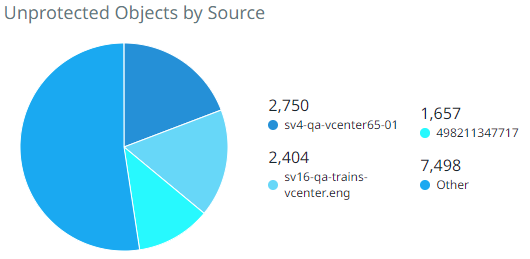Protected / Unprotected Objects
The Protected / Unprotected Objects report provides a summary and list of objects along with their protection status. You can identify objects that are not associated with a Protection Group. The report does not contain data about Cohesity views.
Example use case: Are all the objects in my vCenter protected?
Filter Report Data
The report supports multiple filters to pare down the data that you want to view in the report:
-
System—Select all cluster(s) to include.
-
Source—Select all the sources to include.
-
Type—Choose the types of objects to include — Generic NAS, Isilon, NetApp, Physical, Pure, VMware, and so on.
-
Protection Status—Filter by object protection status — Protected or Unprotected.
-
Object—Enter an object name to filter by the name of the object.
-
Organization—Choose one or more organizations to see the report data specific to the selected organizations.
Glance Bar
The glance bar provides a summary of the report for the specified period:
- Protected Objects—The percentage of Protected Objects to Total Objects.
- Total Sources—The total number of sources.
- Total Objects—The total number of objects.
- Protected Objects—The total number of protected objects.
- Unprotected Objects—The total number of unprotected objects.

Charts
The report includes the following two charts:
-
Protection Status by Type

-
Unprotected Objects by Source

Report Data
The following table describes the data displayed in the Data table. Use the search bar to filter the data by object name, protection status, source, or system name.
You can add or remove columns. For more information, see Customize Table Columns.
| Column Name | Description |
|---|---|
| Object Name | The name of the object. |
| Protection Status | The protection status of the object. |
| Source | The name of the registered source. |
| System | The name of the cluster on which the object is registered. |
| Logical Data |
The combined total of data in the objects that are protected by Cohesity. These metrics are different depending on workload type.
Cohesity does not include unprotected objects in these metrics. |
| Organization | The name specified for the organization when added to the cluster. |
